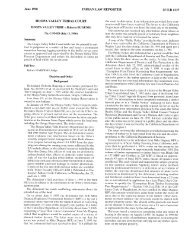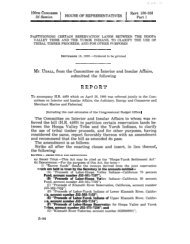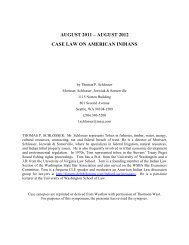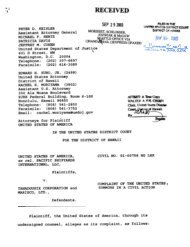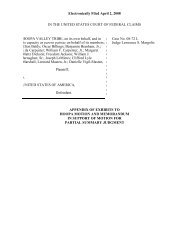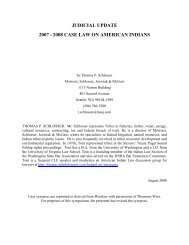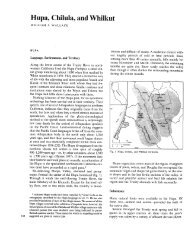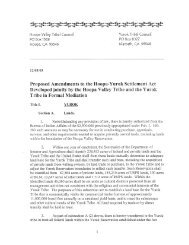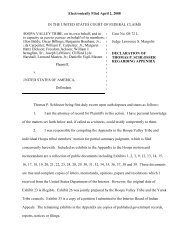Yurok Tribe's Motion to Dismiss U.S. Third Party Complaint
Yurok Tribe's Motion to Dismiss U.S. Third Party Complaint
Yurok Tribe's Motion to Dismiss U.S. Third Party Complaint
Create successful ePaper yourself
Turn your PDF publications into a flip-book with our unique Google optimized e-Paper software.
Case 1:08-cv-00072-TCW Document 39 Filed 11/07/2008 Page 8 of 16<br />
therefore would be distributed <strong>to</strong> the <strong>Yurok</strong> Tribe, pursuant <strong>to</strong> the Act’s provisions. Id. In April<br />
2007, the Government released the <strong>Yurok</strong> Fund <strong>to</strong> the <strong>Yurok</strong> Tribe without any restriction or<br />
reservation. Id.<br />
Disposition of the <strong>Yurok</strong> Fund. The <strong>Yurok</strong> promptly began preparations <strong>to</strong><br />
distribute the funds pursuant the <strong>Yurok</strong> Constitution per capita <strong>to</strong> its members. The Hoopa<br />
Valley Tribe was well aware that the <strong>Yurok</strong> Tribe intended <strong>to</strong> distribute the funds <strong>to</strong> its members.<br />
Indeed, the Hoopa Valley plaintiffs have alleged that the Tribe “warned the Special Trustee” that<br />
such per capita distributions would occur when the <strong>Yurok</strong> funds were released <strong>to</strong> the Tribe. Pls’<br />
Am. Compl. 63. Neither the Hoopa Valley Tribe nor any of its members sought injunctive<br />
relief or <strong>to</strong>ok any other action <strong>to</strong> prevent the Government from releasing the <strong>Yurok</strong> Fund or <strong>to</strong><br />
prevent its distribution <strong>to</strong> <strong>Yurok</strong> members.<br />
As expected, following a vote of the <strong>Yurok</strong> membership, the <strong>Yurok</strong> Tribe began<br />
distributing per capita payments <strong>to</strong> its members in January 2008. Id. Thus, the vast majority –<br />
over 90% – of the <strong>Yurok</strong> Fund was distributed <strong>to</strong> <strong>Yurok</strong> members nearly a year ago. See id.<br />
STANDARD OF REVIEW<br />
For purposes of a motion <strong>to</strong> dismiss, the Court must accept the factual allegations<br />
in the <strong>Complaint</strong> and construe those facts in the light most favorable <strong>to</strong> the plaintiffs but “legal<br />
conclusions, deductions, or opinions couched as factual allegations are not given a presumption<br />
of truthfulness.” Blaze Constr., Inc. v. United States, 27 Fed. Cl. 646, 650 (1993). See also Bell<br />
Atl. Corp. v. Twombly, __ U.S. __, 127 S. Ct. 1955, 1965 (2007) (“[f]actual allegations must be<br />
enough <strong>to</strong> raise a right <strong>to</strong> relief above the speculative level;” a complaint “requires more than<br />
labels and conclusions, and a formulaic recitation of the elements of a cause of action will not<br />
do”). The court “must consider the complaint in its entirety, as well as other sources courts<br />
\\\DC - 024734/000003 - 2815011 v2<br />
8



